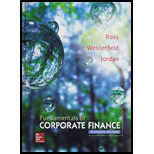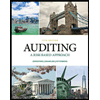
Fundamentals of Corporate Finance with Connect Access Card
11th Edition
ISBN: 9781259418952
Author: Stephen A. Ross Franco Modigliani Professor of Financial Economics Professor, Randolph W Westerfield Robert R. Dockson Deans Chair in Bus. Admin., Bradford D Jordan Professor
Publisher: McGraw-Hill Education
expand_more
expand_more
format_list_bulleted
Question
Chapter 13.4, Problem 13.4BCQ
Summary Introduction
To discuss: The difference between the two types of risk.
Introduction:
Risk refers to the movement or fluctuation in the value of an investment. The movement can be positive or negative. A positive fluctuation in the price benefits the investor. The investor will lose money if the price movement in negative.
Expert Solution & Answer
Want to see the full answer?
Check out a sample textbook solution
Students have asked these similar questions
7. If the inflation rate is 3% and the nominal return on an investment is 8%, what is the real return approximately?
A) 5.0%B) 4.9%C) 5.2%D) 6.0%
7. If the inflation rate is 3% and the nominal return on an investment is 8%, what is the real return approximately?
A) 5.0%B) 4.9%C) 5.2%D) 6.0%need help properly.
Which of the following formulas represents compound interest?
A) I = PRTB) A = P(1 + rt)C) A = P(1 + r/n)^(nt)D) A = P - Ineed help!
Chapter 13 Solutions
Fundamentals of Corporate Finance with Connect Access Card
Ch. 13.1 - How do we calculate the expected return on a...Ch. 13.1 - In words, how do we calculate the variance of the...Ch. 13.2 - What is a portfolio weight?Ch. 13.2 - How do we calculate the expected return on a...Ch. 13.2 - Is there a simple relationship between the...Ch. 13.3 - What are the two basic parts of a return?Ch. 13.3 - Under what conditions will a companys announcement...Ch. 13.4 - Prob. 13.4ACQCh. 13.4 - Prob. 13.4BCQCh. 13.5 - What happens to the standard deviation of return...
Ch. 13.5 - What is the principle of diversification?Ch. 13.5 - Why is some risk diversifiable? Why is some risk...Ch. 13.5 - Why cant systematic risk be diversified away?Ch. 13.6 - Prob. 13.6ACQCh. 13.6 - What does a beta coefficient measure?Ch. 13.6 - True or false: The expected return on a risky...Ch. 13.6 - How do you calculate a portfolio beta?Ch. 13.7 - Prob. 13.7ACQCh. 13.7 - What is the security market line? Why must all...Ch. 13.7 - Prob. 13.7CCQCh. 13.8 - If an investment has a positive NPV, would it plot...Ch. 13.8 - What is meant by the term cost of capital?Ch. 13 - Prob. 13.1CTFCh. 13 - Prob. 13.5CTFCh. 13 - Beta is a measure of what?Ch. 13 - The slope of the security market line is equal to...Ch. 13 - Where would a negative net present value project...Ch. 13 - Prob. 1CRCTCh. 13 - Prob. 2CRCTCh. 13 - Systematic versus Unsystematic Risk [LO3] Classify...Ch. 13 - Systematic versus Unsystematic Risk [LO3] Indicate...Ch. 13 - Prob. 5CRCTCh. 13 - Diversification [LO2] True or false: The most...Ch. 13 - Portfolio Risk [LO2] If a portfolio has a positive...Ch. 13 - Beta and CAPM[LO4] Is it possible that a risky...Ch. 13 - Corporate Downsizing [LO1] In recent years, it has...Ch. 13 - Earnings and Stock Returns [LO1] As indicated by a...Ch. 13 - Determining Portfolio Weights [LO1] What are the...Ch. 13 - Portfolio Expected Return [LO1] You own a...Ch. 13 - Portfolio Expected Return [LO1] You own a...Ch. 13 - Prob. 4QPCh. 13 - Prob. 5QPCh. 13 - Prob. 6QPCh. 13 - Calculating Returns and Standard Deviations [LO1]...Ch. 13 - Calculating Expected Returns [LO1] A portfolio is...Ch. 13 - Returns and Variances [LO1] Consider the following...Ch. 13 - Returns and Standard Deviations [LO1] Consider the...Ch. 13 - Calculating Portfolio Betas [LO4] You own a stock...Ch. 13 - Calculating Portfolio Betas [LO4] You own a...Ch. 13 - Using CAPM[LO4] A stock has a beta of 1.15, the...Ch. 13 - Using CAPM[LO4] A stock has an expected return of...Ch. 13 - Using CAPM [LO4] A stock has an expected return of...Ch. 13 - Using CAPM [LO4] A stock has an expected return of...Ch. 13 - Using the SML[LO4] Asset W has an expected return...Ch. 13 - Reward-to-Risk Ratios [LO4] Stock Y has a beta of...Ch. 13 - Reward-to-Risk Ratios [LO4] In the previous...Ch. 13 - Using CAPM [LO4] A stock has a beta of 1.14 and an...Ch. 13 - Portfolio Returns [LO2] Using information from the...Ch. 13 - Prob. 22QPCh. 13 - Portfolio Returns and Deviations [LO2] Consider...Ch. 13 - Analyzing a Portfolio [LO2, 4] You want to create...Ch. 13 - Analyzing a Portfolio [LO2, 4] You have 100,000 to...Ch. 13 - Systematic versus Unsystematic Risk [LO3] Consider...Ch. 13 - SML [LO4] Suppose you observe the following...Ch. 13 - SML [LO4] Suppose you observe the following...Ch. 13 - Prob. 1MCh. 13 - Beta is often estimated by linear regression. A...Ch. 13 - Prob. 3MCh. 13 - Prob. 4MCh. 13 - Prob. 5M
Knowledge Booster
Similar questions
- Which of the following formulas represents compound interest? A) I = PRTB) A = P(1 + rt)C) A = P(1 + r/n)^(nt)D) A = P - Iarrow_forwardA bond pays annual coupons of $60 and is currently priced at $1,050. What is its current yield? A) 6.0% B) 5.7% C) 5.5% D) 5.0% explainarrow_forward8. A bond pays annual coupons of $60 and is currently priced at $1,050. What is its current yield? A) 6.0%B) 5.7%C) 5.5%D) 5.0% helparrow_forward
- 8. A bond pays annual coupons of $60 and is currently priced at $1,050. What is its current yield? A) 6.0%B) 5.7%C) 5.5%D) 5.0%arrow_forwardWhat is the effective annual rate (EAR) if the nominal rate is 12% compounded quarterly? A) 12.55%B) 12.00%C) 12.36%D) 12.82% need help!arrow_forwardWhat is the effective annual rate (EAR) if the nominal rate is 12% compounded quarterly? A) 12.55%B) 12.00%C) 12.36%D) 12.82%arrow_forward
- A loan of $10,000 is to be repaid in equal annual installments over 4 years at 5% interest. What is the annual installment? A) $2,564.57B) $2,856.44C) $2,312.49D) $2,775.60arrow_forward1. What is the simple interest on a loan of $5,000 at 6% per annum for 3 years? A) $900B) $750C) $1,200D) $600arrow_forwardWhat is the monthly payment on a $12,000 loan at 6% annual interest, to be repaid over 1 year? A) $1,030.33B) $1,033.00C) $1,035.45D) $1,050.00need help!!arrow_forward
- What is the monthly payment on a $12,000 loan at 6% annual interest, to be repaid over 1 year? A) $1,030.33B) $1,033.00C) $1,035.45D) $1,050.00arrow_forward4. A stock pays an annual dividend of $3 and is currently priced at $60. What is the dividend yield? A) 4%B) 5%C) 6%D) 3%arrow_forward4. A stock pays an annual dividend of $3 and is currently priced at $60. What is the dividend yield? A) 4%B) 5%C) 6%D) 3%need help!!arrow_forward
arrow_back_ios
SEE MORE QUESTIONS
arrow_forward_ios
Recommended textbooks for you
- Business Its Legal Ethical & Global EnvironmentAccountingISBN:9781305224414Author:JENNINGSPublisher:Cengage
 Cornerstones of Financial AccountingAccountingISBN:9781337690881Author:Jay Rich, Jeff JonesPublisher:Cengage Learning
Cornerstones of Financial AccountingAccountingISBN:9781337690881Author:Jay Rich, Jeff JonesPublisher:Cengage Learning  Auditing: A Risk Based-Approach (MindTap Course L...AccountingISBN:9781337619455Author:Karla M Johnstone, Audrey A. Gramling, Larry E. RittenbergPublisher:Cengage Learning
Auditing: A Risk Based-Approach (MindTap Course L...AccountingISBN:9781337619455Author:Karla M Johnstone, Audrey A. Gramling, Larry E. RittenbergPublisher:Cengage Learning Managerial Accounting: The Cornerstone of Busines...AccountingISBN:9781337115773Author:Maryanne M. Mowen, Don R. Hansen, Dan L. HeitgerPublisher:Cengage Learning
Managerial Accounting: The Cornerstone of Busines...AccountingISBN:9781337115773Author:Maryanne M. Mowen, Don R. Hansen, Dan L. HeitgerPublisher:Cengage Learning EBK CONTEMPORARY FINANCIAL MANAGEMENTFinanceISBN:9781337514835Author:MOYERPublisher:CENGAGE LEARNING - CONSIGNMENT
EBK CONTEMPORARY FINANCIAL MANAGEMENTFinanceISBN:9781337514835Author:MOYERPublisher:CENGAGE LEARNING - CONSIGNMENT

Business Its Legal Ethical & Global Environment
Accounting
ISBN:9781305224414
Author:JENNINGS
Publisher:Cengage

Cornerstones of Financial Accounting
Accounting
ISBN:9781337690881
Author:Jay Rich, Jeff Jones
Publisher:Cengage Learning


Auditing: A Risk Based-Approach (MindTap Course L...
Accounting
ISBN:9781337619455
Author:Karla M Johnstone, Audrey A. Gramling, Larry E. Rittenberg
Publisher:Cengage Learning

Managerial Accounting: The Cornerstone of Busines...
Accounting
ISBN:9781337115773
Author:Maryanne M. Mowen, Don R. Hansen, Dan L. Heitger
Publisher:Cengage Learning

EBK CONTEMPORARY FINANCIAL MANAGEMENT
Finance
ISBN:9781337514835
Author:MOYER
Publisher:CENGAGE LEARNING - CONSIGNMENT